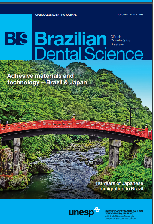In vitro analysis of dental ceramics: evaluation of the radiopacity and chemical composition by raman spectroscopy
DOI:
https://doi.org/10.14295/bds.2018.v21i2.1504Abstract
Objective: This study compared the radiopacity of different ceramic systems by means of digital radiographs and evaluate the chemical composition of the samples by Raman spectroscopy. Material and Methods: The hypothesis tested was that there was a difference in radiopacity among the tested materials. Specimens were prepared for each ceramic tested: FLD - VM7 (VITA Zahnfabrik), LD - IPS Empress e.max Press (IPS Empress), AL - In Ceram Alumina (VITA Zahnfabrik), ALYZ - In Ceram Zirconia (VITA Zahnfabrik), YZ - Lava All Ceram (3M/ESPE), and MYZ - Zirconzahn (Talladium Brazil). The specimens were radiographed and submitted to radiographic density readings using a histogram tool. The spectrometer coupled to a petrographic microscope was used for Raman spectroscopy measurements. Analysis of variance (ANOVA) and a Tukey post-hoc test were used to compare radiopacity of the different materials. Results: For all tested materials, the radiopacity showed statistically significant differences, except YZ and MYZ. Lava All Ceram and ZirkonZahn had high radiopacity values and VM7 and IPS Empress e.max Press showed lower radiopacity than human dental structures. Conclusion: It was possible to conclude that radiopacity is closely linked to ceramic chemical composition.
Keywords
Dental ceramics; Radiopacity; Raman spectroscopy test; Restorative dentistry.
Downloads
Downloads
Published
How to Cite
Issue
Section
License
Brazilian Dental Science uses the Creative Commons (CC-BY 4.0) license, thus preserving the integrity of articles in an open access environment. The journal allows the author to retain publishing rights without restrictions.
=================




























